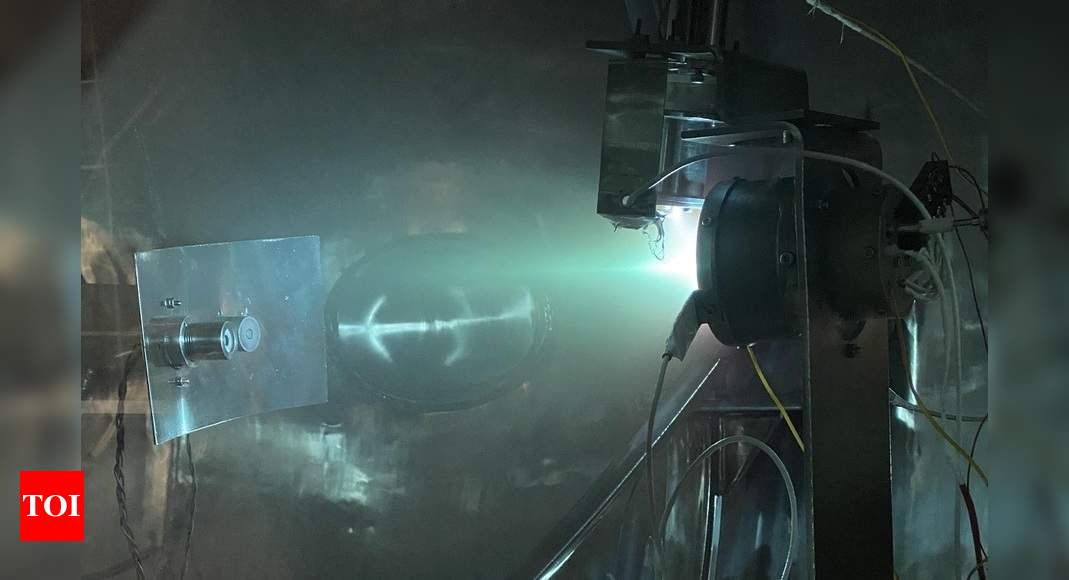In a first, space transportation firm Bellatrix Aerospace has tested the country’s first privately built Hall Thruster, a highly efficient electric propulsion system for satellites.
Tests were carried out at the sophisticated spacecraft propulsion research laboratory Bellatrix has set up at the Indian Institute of Science’s (IISc) Society for Innovation and Development (SID).
The company had earlier developed the world’s first commercial Microwave Plasma Thruster, which used water as fuel, and for which the company had bagged an order from Isro.
A Hall Thruster, initially developed in Russia, is a device that employs electric and magnetic fields to ionize propellant gases such as Xenon to produce thrust.
Today, it is the most reliable and time tested electric propulsion system in the global market.
Bellatrix CEO and CTO Rohan M Ganapthy, told TOI: “The company has been working on this technology in stealth mode for four years.
The Heaterless Cathode Technology is the key innovation that sets us apart from the competition by increasing life and redundancy and life of the system.
We are also the first ones in the country to have designed it to operate efficiently at very low current levels.
” The firm’s Electric Propulsion System Division (EPSD), led by senior scientist Rajesh Natarajan played a key role in developing the thruster that’s ideal for micro satellites weighing 50kg to 500kg and can be scaled up for heavier satellites.
The company said it also forms a critical technology for the Space Taxi it is developing.
Bellatrix had earlier announced collaborations with other space companies, Satsure, Skyroot Aerospace and Dhruva Space on its ambitious orbital transfer vehicle (OTV) mission.
Compared to conventional chemical propulsion technologies, electric propulsion systems offer much higher specific impulse, mileage, thus allowing satellites to carry more useful transponders and achieve 3X higher return on investment.
Bellatrix’s current model uses Xenon as fuel but the firm is working on other proprietary propellants that can make the propulsion system more compact and cost efficient.
Natarajan said: “The major challenge around comes with the complex plasma physics and precise engineering involved in taming the plasma behavioür.
The plasma must be isolated from the walls of the thruster, hence, smaller the thruster, the more complex it gets.
The way to achieve this is less known.
We have succeeded in developing the smallest Hall Thruster in the country”, he explains.
Rajesh Natarajan, a senior Scientist at EPSD division at Bellatrix who played a key role in this development talks about the journey through the development phase.
“The major challenge around Hall Thrusters comes with the complex plasma physics and precise engineering involved in taming the plasma behavior.
The plasma must be isolated from the walls of the thruster, hence, smaller the thruster, the more complex it gets.
The way to achieve this is less known.
We have succeeded in developing the smallest Hall Thruster in India.
” Additionally, Bellatrix Aerospace is also developing a green chemical propulsion system that forms an eco-friendly high performance alternative for toxic and carcinogenic Hydrazine based propellants.
“With this addition to our portfolio, we are in a position to offer best in class electric propulsion systems.
We have designed this thruster with numerous considerations that make it an ideal engine to power the major satellite constellations that will be launched during this decade.
It offers class-leading performance and life.
Our Microwave Plasma Thrusters offer the highest thrust-to-power ratio for heavier satellites”, added Rohan.
Bellatrix is working towards flying this thruster on a satellite mission in the coming months.
This will open the company’s gateway to the commercial market by the end of this year.







